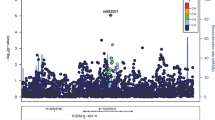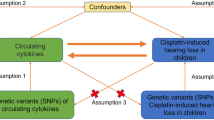Abstract
Cisplatin is a widely used chemotherapy drug in the treatment of pediatric solid tumors, but it is associated with significant rates of ototoxicity (medication-induced hearing loss). A genetic test has recently been developed that can help predict the likelihood that a cisplatin-treated pediatric patient will develop ototoxicity. This study estimates the potential economic impact of this test. Assuming that an alternative, non-preferred, medication to cisplatin exists that it is as efficacious as cisplatin but without the risk of hearing loss, and that the alternative treatment is no more expensive than current practice, we have estimated that administering this genetic test to every pediatric cancer patient for whom cisplatin is first-line therapy could potentially avoid an average of $71 168 in societal costs per tested patient. This translates into a potential present value savings of over $2.4 million annually in British Columbia and over $19.6 million in Canada.
This is a preview of subscription content, access via your institution
Access options
Subscribe to this journal
Receive 6 print issues and online access
$259.00 per year
only $43.17 per issue
Buy this article
- Purchase on Springer Link
- Instant access to full article PDF
Prices may be subject to local taxes which are calculated during checkout
Similar content being viewed by others
References
Dhooge I, Dhooge C, Geukens S, De Clerk B, De Vel E, Vinck B . Distortion product otoacoustic emissions: an objective technique for the screening of hearing loss in children treated with cisplatin. Int J Audiol 2006; 45: 337–343.
van den Berg JH, Beijnen JH, Balm AJM, Schellens JHM . Future opportunities in preventing cisplatin induced ototoxicity. Cancer Treat Rev 2006; 32: 390–397.
Li Y, Womer RB, Silber J . Predicting cisplatin ototoxicity in children: the influence of age and the cumulative dose. Eur J Cancer 2004; 40: 2445–2451.
Coradini PP, Cigana L, Selistre SG, Rosito LS, Brunetto AL . Ototoxicity from cisplatin therapy in childhood cancer. J Pediatr Hematol Oncol 2007; 29: 355–360.
Knight KR, Kraemer DF, Neuwelt EA . Ototoxicity in children receiving platinum chemotherapy: underestimating a commonly occurring toxicity that may influence academic and social development. J Clin Oncol 2005; 23: 8588–8596.
Kushner BH, Budnick A, Kramer K, Modak S, Cheung NK . Ototoxicity from high-dose use of platinum compounds in patients with neuroblastoma. Cancer 2006; 107: 417–422.
Schroeder L, Petrou S, Kennedy C, McCann D, Law C, Watkin PM et al. The economic costs of congenital bilateral permanent childhood hearing impairment. Pediatrics 2006; 117: 1101–1112.
Ross CJD, Katzov-Eckert H, Dubé M-P, Brooks B, Rassekh SR, Barhdadi A et al. Genetic variants in TPMT and COMT are associated with hearing loss in children receiving cisplatin chemotherapy. Nat Genet 2009; 41: 1345–1349.
Bank of Canada. Inflation calculator. Retrieved at: http://www.bankofcanada.ca/en/rates/inflation_calc.html.
Mohr PE, Feldman JJ, Dunbar JL, McConkey-Robbins A, Niparko JK, Rittenhouse RK et al. The societal costs of severe to profound hearing loss in the United States. Int J Technol Assess Health Care 2000; 16: 1120–1135.
Statistics Canada. Average earnings by sex and work pattern. Retrieved at: http://www40.statcan.ca/l01/cst01/labor01a-eng.htm.
Centers for Disease Control Prevention (CDC). Economic costs associated with mental retardation, cerebral palsy, hearing loss, and vision impairment—United States. Morb Mortal Wkly Rep 2004; 53: 57–59.
Canadian Cancer Society. Canadian Cancer Statistics 2009. 2009 Retrieved at: http://www.cancer.ca/~/media/CCS/Canada%20wide/Files%20List/English%20files%20heading/pdf%20not%20in%20publications%20section/Stats%202009E%20Cdn%20Cancer.ashx.
Phillips B, Powers BE, Dernell WS, Straw RC, Khanna C, Hogge GS et al. Use of single-agent carboplatin as adjuvant or neoadjuvant therapy in conjunction with amputation for appendicular osteosarcoma in dogs. J Am Anim Hosp Assoc 2009; 45: 33–38.
Robson H, Meyer S, Shalet SM, Anderson E, Roberts S, Eden OB . Platinum agents in the treatment of osteosarcoma: efficacy of cisplatin vs. carboplatin in human osteosarcoma cell lines. Med Pediatr Oncol 2002; 39: 573–580.
Simon T, Hero B, Dupuis W, Selle B, Berthold F . The incidence of hearing impairment after successful treatment of neuroblastoma. Klin Padiatr 2002; 214: 149–152.
Mann JR, Raafat F, Robinson K, Imeson J, Gornall P, Sokal M et al. The United Kingdom Children's Cancer Study Group's second germ cell tumor study: carboplatin, etoposide, and bleomycin are effective treatment for children with malignant extracranial germ cell tumors, with acceptable toxicity. J Clin Oncol 2000; 18: 3809–3818.
Haberle B, Bode U, Von Schweinitz D . Differentiated treatment protocols for high- and standard-risk hepatoblastoma—an interim report of the German Liver Tumor Study HB99. Klin Padiatr 2003; 215: 159–165.
Fouladi M, Chintagumpala M, Ashley D, Kellie S, Gururangan S, Hassall T et al. Amifostine protects against cisplatin-induced ototoxicity in children with average-risk medulloblastoma. J Clin Oncol 2008; 26: 3749–3755.
Papsin BC, Gordon KA . Cochlear implants for children with severe-to-profound hearing loss. N Engl J Med 2007; 357: 2380–2387.
Snik FM, van Duijnhoven NTL, Mylanus EAM, Cremers WRJ . Estimated cost-effectiveness of active middle-ear implantation in hearing-impaired patients with severe external otitis. Arch Otolaryngol Head Neck Surg 2006; 132: 1210–1215.
For Deaf People (fdp) 2010##Social impact of hearing loss. Retrieved at: http://www.fdp.org.uk/articles/social-impact.html.
Fellinger J, Holzinger D, Sattel H, Laucht M . Mental health and quality of life in deaf pupils. Eur Child Adolesc Psychiatry 2008; 17: 414–423.
Hallam R, Ashton P, Sherbourne K, Gailey L . Persons with acquired profound hearing loss (APHL): how do they and their families adapt to the challenge? Health 2008; 12: 369–388.
Mason A, Mason M . Psychologic impact of deafness on the child and adolescent. Prim Care 2007; 34: 407–426.
Berk L . Emotional and social development in adolescence. In: Development Through the Lifespan, 2nd edn Allyn & Bacon: Needham Heights, MA, 2001, pp 388–417.
The Lancet. Taking childhood hearing loss seriously. Lancet 2007; 369: 1234.
Author information
Authors and Affiliations
Corresponding author
Ethics declarations
Competing interests
The authors declare no conflict of interest.
Appendix A
Appendix A
Annual costs associated with ototoxicity
Children diagnosed with ototoxicity between the ages of 0 and 5



Children diagnosed with ototoxicity between the ages of 6 and 11



Children diagnosed with ototoxicity between the ages of 12 and 18



Notes:
-
All cost estimates, except the therapy/support services (see below), were provided by Beth Brooks, Registered Audiologist, BC Children's Hospital and validated by two other audiologists: Anne Follows, BC Early Hearing Program Hearing Equipment Plan Manager, Regional Coordinator and Audiologist Nanaimo Health Unit Audiology Clinic and an audiologist working in sales with a private equipment supplier.
-
These cost estimates are specific to BC but while Beth Brooks acknowledges that there are regional variations in costs and funding mechanisms, in her opinion (supported by the audiologist working in sales with a private equipment supplier), these estimates are reasonably reflective of both professional services and equipment costs across North America.
Therapy/support services
-
The $18 300 per year for grade 3 or 4 hearing loss for school-related services is paid for by the Ministry of Education. Ministry of Education website http://www.bced.gov.bc.ca/specialed/special_ed_policy_manual.pdfpage=108 section H13 page 144
-
The $6600 per year for grade 3 or 4 hearing loss pre-schoolers is provided through the BC Early Hearing Program for children diagnosed with such hearing loss before 2 years old. Children diagnosed between ages 2 and 5 years have similar coverage provided through different programs—we used the same $6600 to estimate the total value of these other programs. The BC Early Hearing Program and other programs only include 2 years of direct funding. Funding for remaining years comes from public health infant/pre-school services, private insurance or out-of-pocket spending (therefore, classified as health-care costs).
Equipment
-
The yearly costs for hearing aids have been calculated based on binaural amplification with replacement every 4 years including earmolds, batteries and fitting fees as follows:
-
○ Hearing aid @ $1200 * 2 ears=$2400/4 years=$600/year
-
○ Batteries @ $1 * 6/month * 2 ears *12 months=$144/year
-
○ Earmolds @ $45 * 2 ears * 3 sets/year (average for children <6 years old)=$270
-
○ Earmolds @ $45 * 2 ears * 1 set/year (average for children 6 years old or greater)=$90
-
○ Total hearing aid cost/year:
-
Age 0–6 years: $600+$144+$270=$1014
-
Age >6 years: $600+$144 +$ 90=$834
-
-
○ For adults, the equipment cost is the same but earmolds are needed only every 4 years with the new hearing aids; therefore, the annual cost is estimated at $766.50 ($600 for the hearing aids, $144 for batteries and $22.50 for the earmolds)
-
These are current costs in 2011 based on manufacturers’ pricing less discounts passed on by public health services plus fitting fees. Hearing aid costs in the private sector tend to be higher ($1500–$2000 per hearing aid plus batteries and earmolds). This calculation assumes adequately stable hearing levels not requiring change of hearing aid.
-
The yearly cost for FM systems has been calculated based on binaural fitting with replacement every 5 years including estimated costs for maintenance/repair/replacement parts as follows:
-
Binaural system=$3200/5 years=$640/year
-
Microphone replacement=2 * $150=$300/5 years=$60
-
Maintenance/repairs=$800/5 years=$160
-
Total FM cost/year=$640+$60+$160=$860/year
-
These are current costs in 2011 based on manufacturers’ pricing purchased through public health services for use in any environment (school, home, recreation and so on). Due to bulk purchase by Ministry of Education in British Columbia, FM for school use only is less.
Rights and permissions
About this article
Cite this article
Dionne, F., Mitton, C., Rassekh, R. et al. Economic impact of a genetic test for cisplatin-induced ototoxicity. Pharmacogenomics J 12, 205–213 (2012). https://doi.org/10.1038/tpj.2011.15
Received:
Revised:
Accepted:
Published:
Issue Date:
DOI: https://doi.org/10.1038/tpj.2011.15
Keywords
This article is cited by
-
A Systematic Review of Economic Evaluations of Pharmacogenetic Testing for Prevention of Adverse Drug Reactions
PharmacoEconomics (2016)
-
Challenges in Interpreting the Evidence for Genetic Predictors of Ototoxicity
Clinical Pharmacology & Therapeutics (2013)



